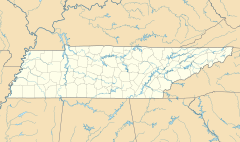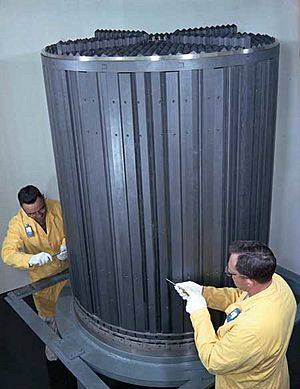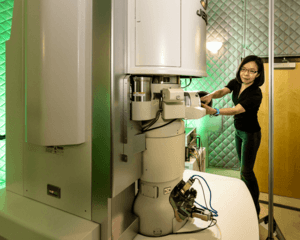Oak Ridge National Laboratory facts for kids
 |
|
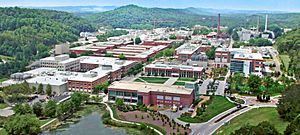
Aerial view of ORNL's main campus in 2014
|
|
| Motto | "Solving Big Problems" |
|---|---|
| Established | 1943 |
| Research type | Multidisciplinary |
| Budget | US$2.4 billion |
|
Field of research
|
|
| Director | Thomas Zacharia |
| Staff | 5,700 |
| Location | Oak Ridge, Tennessee, United States 35°56′N 84°19′W / 35.93°N 84.31°W |
| Campus | ORNL occupies about 10,000 acres (40 km2) of the approximately 35,000 acres (140 km2) Oak Ridge Reservation |
| Affiliations | United States Department of Energy (DOE) |
|
Operating agency
|
UT–Battelle |
| Map | |
The Oak Ridge National Laboratory (ORNL) is a huge science and technology lab in the United States. It's located in Oak Ridge, Tennessee. The United States Department of Energy (DOE) supports it. A group called UT–Battelle helps manage and run the lab.
ORNL started in 1943. It's the biggest science and energy lab in the Department of Energy system. It focuses on many areas like materials, nuclear science, neutron science, energy, supercomputing, systems biology, and national security. Sometimes, it works with the state of Tennessee, universities, and other companies.
The lab is home to some of the world's most powerful supercomputers. This includes Frontier, which was once ranked as the world's most powerful. ORNL is also a top place for neutron and nuclear power research. It has special facilities like the Spallation Neutron Source and the High Flux Isotope Reactor.
Contents
What is Oak Ridge National Laboratory?
Oak Ridge National Laboratory is managed by UT–Battelle. This is a partnership between the University of Tennessee and the Battelle Memorial Institute. They started working together in 2000 to run the lab.
As of 2021, about 5,700 people work at ORNL. Around 2,000 of them are scientists and engineers. Plus, about 3,200 guest researchers visit the lab each year. The lab's yearly budget is about $2.4 billion.
The lab is part of a larger area called the Oak Ridge Reservation. This area is about 150 square kilometers (58 square miles). ORNL itself takes up about 18 square kilometers (7 square miles) of this land.
History of ORNL
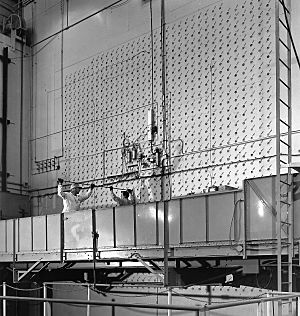
The city of Oak Ridge was created in 1942. It was built by the United States Army Corps of Engineers for a secret project called the Manhattan Project. This project aimed to develop the first atomic bombs during World War II.
In 1943, the "Clinton Laboratories" were finished. These labs were later renamed "Oak Ridge National Laboratory." The site was chosen for the X-10 Graphite Reactor. This reactor was used to make plutonium for the Manhattan Project. Enrico Fermi, a famous scientist, helped develop the world's second self-sustaining nuclear reactor here. The X-10 was the first reactor designed to run all the time.
After World War II ended, the need for plutonium decreased. The lab then focused on scientific research. In 1946, ORNL produced the first medical isotopes. These are special radioactive materials used in medicine. By 1950, nearly 20,000 samples had been sent to hospitals.
Alvin Weinberg became the Director of Research at ORNL in 1955. He led the lab for many years.
Nuclear Research and Energy
In the 1950s, much of ORNL's research focused on using nuclear reactors to create energy. This included energy for power plants and even for ships. More reactors were built at ORNL during this time than in all other years combined.
One important project was the world's first light water reactor. This type of reactor is the ancestor of most modern nuclear power stations. The U.S. Military helped fund its development. They wanted to use it for nuclear-powered submarines and ships.
ORNL also designed small, portable nuclear reactors in 1953. The U.S. Army used these for heat and electricity in faraway military bases. The United States Air Force also helped fund some reactors and the lab's first computers. ORNL even designed a nuclear-powered aircraft in 1954, though it never flew.
The X-10 reactor continued to produce radionuclides for medicine. ORNL was the only Western source of californium-252, a special element. ORNL scientists also did the world's first successful bone marrow transplant on mice.
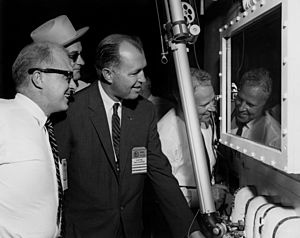
In the 1960s, ORNL worked on desalination plants. These plants would use nuclear power to turn saltwater into fresh water. This project was called Water for Peace. It was supported by Presidents John F. Kennedy and Lyndon B. Johnson. However, the plan didn't work out due to rising costs and less public trust in nuclear power.
The Molten-Salt Reactor Experiment ran from 1966 to 1969. It showed that molten salt reactors could work. The High Flux Isotope Reactor (HFIR) was built in 1965. It had the highest neutron flux (a measure of neutron intensity) of any reactor at the time. It helped produce more medical isotopes and allowed better materials research.
New Discoveries and Challenges
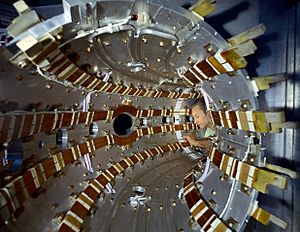
In the 1970s, ORNL started researching fusion power. This is a way to create energy by combining atoms, like the sun does. A device called ORMAK was built in 1971. It was the first tokamak (a type of fusion reactor) to reach a plasma temperature of 20 million Kelvin.
ORNL also helped improve safety standards for nuclear reactors in the 1970s. They wrote nearly 100 requirements for things like fuel transport and earthquake resistance. In 1979, ORNL helped analyze the damage to the Three Mile Island Nuclear Generating Station after an accident there.
In 1972, a biologist at ORNL named Peter Mazur successfully froze and thawed mouse embryos. The mouse pups were born healthy. This technique is now used in the livestock industry to transport embryos easily.
In the 1980s, ORNL focused on making things more efficient. They built a special chamber to test how well insulation worked in different weather conditions. They also researched heat-resistant ceramics for car engines. The High Temperature Materials Laboratory was set up in 1987. Here, ORNL and industry researchers worked together on ceramic and alloy projects.
In 1981, the Holifield Heavy Ion Research Facility opened. This was a powerful particle accelerator. It attracted many guest researchers each year.
The Department of Energy started cleaning up pollution around ORNL in the 1980s. Old waste sites had contaminated the groundwater. This cleanup cost hundreds of millions of dollars.
In 1992, a person named Charles Varnadore raised concerns about safety at ORNL. His actions led to better protection for whistleblowers (people who report problems) within the Department of Energy.
In 2019, ORNL made a big step forward in making Pu-238. This material is used to power space exploration programs for NASA. They increased production from 50 grams to 400 grams per year.
Areas of Research at ORNL
ORNL does research in many different science areas. Often, researchers work on projects that combine several fields. Here are some of the main research areas:
Chemical Sciences
ORNL studies how chemicals work. This includes looking at catalysis (speeding up chemical reactions) and surface science. They also study how to separate different chemicals and how to make new materials like polymers.
Electron Microscopy
ORNL uses powerful electron microscopes to study tiny things. They look at materials, chemicals, and nanomaterials to understand how they behave.
Nuclear Medicine
This research focuses on making medical radioisotopes. These are used in nuclear medicine and cancer treatment. They also develop new ways to produce these materials.
Physics
Physics research at ORNL looks at the basic properties of matter. This includes studying atoms, nuclei, and even smaller particles. They also build special equipment for these studies.
Population Studies
ORNL creates a global population map called LandScan. This map shows where people live in small areas (about 1 square kilometer). It helps organizations understand population distribution. This data is updated yearly and is used by groups like USAID.
Energy Research
ORNL has a long history of energy research, especially with nuclear reactors. They work to make nuclear reactors more efficient and safer. This includes developing better materials, more accurate computer models, and improved safety procedures.
The Energy Efficiency and Electricity Technologies Program (EEETP) works to improve air quality and reduce the U.S.'s need for foreign oil. They focus on electricity, manufacturing, and transportation. For example, they aim to create affordable, carbon-neutral homes. They also research better solar panels, geothermal energy, and wind power.
Fusion power is another area of research at ORNL. They work on developing parts like high temperature superconductors and materials for future fusion reactors. They also study plasma physics to understand how to control the hot gas needed for fusion. ORNL hosts the U.S. office for ITER, a huge international fusion project.
Biology Research
ORNL's biology research covers genomics (studying genes), computational biology (using computers for biology), and bioinformatics (managing biological data). The BioEnergy Program tries to make the process of creating biofuels more efficient. They want to improve plants used for biofuel and find better ways to turn them into energy.
The Center for Molecular Biophysics studies how biological molecules behave. They look at things like cell walls for biofuel production and use neutron scattering to study protein folding.
Neutron Science
ORNL has three neutron sources: the High Flux Isotope Reactor (HFIR), the Oak Ridge Electron Linear Accelerator (ORELA), and the Spallation Neutron Source (SNS). HFIR provides a steady beam of neutrons, while ORELA and SNS produce pulses of neutrons.
HFIR started in 1965 and is used for materials research and making medical radioisotopes. It has the world's highest constant neutron flux. HFIR helped produce the element tennessine.
The Spallation Neutron Source (SNS) is a particle accelerator that creates the most intense neutron pulses of any man-made source. SNS started in 2006 and has been upgraded to be even more powerful. Stronger neutron pulses mean clearer images of materials and more accurate results.
Materials Science
ORNL researches materials science in many areas. For example, they worked with Caterpillar Inc. to create a new steel for diesel engines. This new steel, called CF8C Plus, can handle big temperature changes better.
The High-Temperature Materials Lab at ORNL allows researchers from universities and companies to use their facilities. The Center for Nanophase Materials Sciences (CNMS) studies tiny nanomaterials. In 2012, CNMS created a new type of battery that could store much more energy than current lithium ion batteries.
Security Research
Oak Ridge National Laboratory helps the United States Department of Homeland Security and other defense programs. The Global Security and Nonproliferation (GS&N) program works to prevent the spread of nuclear materials. They develop ways to detect stolen nuclear material and guide how to dismantle nuclear weapons. They also work on detecting chemical and biological agents.
High-Performance Computing
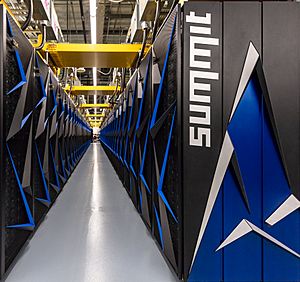
ORNL has been home to some of the fastest supercomputers in the world. In 1953, they built ORACLE (Oak Ridge Automatic Computer and Logical Engine) for science research.
In 2005, Jaguar was built. It was upgraded over time and became the world's fastest supercomputer from 2009 to 2010. Later, Jaguar was upgraded again and renamed Titan. Titan was also ranked as the world's fastest supercomputer in 2012.
In 2018, Summit was built at ORNL. It was the world's fastest supercomputer from November 2018 to June 2020. As of June 2020, Summit was the second fastest. It has over 200,000 CPU cores and a huge amount of storage.
Since 1992, the National Center for Computational Sciences (NCCS) has managed high-performance computing at ORNL. They oversee the Oak Ridge Leadership Computing Facility, where these powerful machines are located.
In 1989, programmers at ORNL created Parallel Virtual Machine (PVM) software. This software helps different computers work together on big tasks. It became a very popular tool for distributed computing.
Notable People
- Elda Emma Anderson
- Manson Benedict
- Leslie Benmark
- Jane Blankenship
- Everitt P. Blizard
- Lyle Benjamin Borst
- Hermann Bottenbruch
- Marilyn A. Brown
- Thure E. Cerling
- Robert Coveyou
- Sheldon Datz
- Jack Dongarra
- John H. Ebersole
- Julie Ezold
- John H. Gibbons (scientist)
- Amit Goyal
- Eugene Guth
- Michael Heath (computer scientist)
- Linda Horton
- Alston Scott Householder
- Chun-Hway Hsueh
- George Samuel Hurst
- Mujaddid Ahmed Ijaz
- Sergei V. Kalinin
- William Rudolph Kanne
- Cresson Kearny
- Tamara G. Kolda
- Clarence Larson
- Henri A. Levy
- Dan Lindsley
- Herbert G. MacPherson
- William Madia
- Thomas Mason (physicist)
- Dade Moeller
- G. William Morgan
- Karl Z. Morgan
- Stephen E. Nagler
- Jagdish Narayan
- Peter Nellist
- C. Maurice Patterson
- Clarice Phelps
- Frances Pleasonton
- Ward Plummer
- Herman Postma
- Red Raper
- Hyman G. Rickover
- Larry Robinson (chemist)
- Amy Rosemond
- Liane Russell
- Clifford Shull
- David Joseph Singh
- Nicholas M. Smith Jr.
- Olaf Storaasli
- Jan B. Talbot
- Arpad Vass
- Alvin M. Weinberg
- Eugene Wigner
- Ernest O. Wollan
- Ying Xu
- Herbert York
- Gale J. Young
- Thomas Zacharia
See also
 In Spanish: Laboratorio Nacional Oak Ridge para niños
In Spanish: Laboratorio Nacional Oak Ridge para niños


